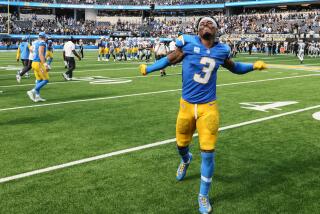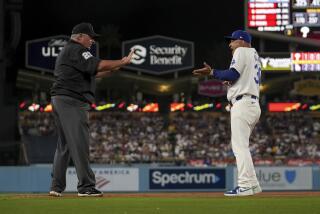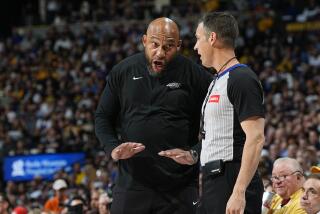Analysis : ‘Instant’ Replay Takes Much Too Long
HOUSTON — In the Astrodome Sunday, the National Football League’s instant replay people again tried to call one that was a bit too close to call.
All year, they’ve attempted to be too fine.
And so doing, they have unnecessarily delayed too many games, including this one, which went on and on for more than 3 1/2 hours.
Before the Raiders eventually won their fifth straight, 28-17, the officials wasted an estimated five to eight minutes on one occasion, studying a fumble by Raider quarterback Marc Wilson, whose knee might or might not have touched the AstroTurf in the first quarter before he lost the ball.
The league’s press box official, Mike Lisetski, first ruled it no fumble, then saw another replay picture and called it a fumble because Wilson’s knee apparently hadn’t yet hit the ground when he lost control of the ball.
Finally, referee Dick Jorgensen ruled against the Oilers. He said that, before Wilson lost possession, “We had killed the play with a whistle (by head linesman Ron Phares).”
Then, explaining the delay, Jorgensen alluded to the replay arbiter and said: “We had a conversation back and forth to make sure we had the right answer.”
This is precisely what, under NFL rules, the officials--upstairs and downstairs--shouldn’t have done.
These rules specify that in case of doubt, the play--any play--stands if the replay official can’t reverse it within a period of approximately 20 seconds.
The league’s operative phrase is “indisputable visual evidence.” Unless the replay official is convinced within 20 seconds or so that the evidence is visually indisputable, he is required by NFL rules to support the man who made the call on the field.
Commissioner Pete Rozelle and other league officials have said repeatedly that the NFL’s only reason for using replay pictures this year is to correct the big, obvious blunder--for instance, the midair fumble that is visible to every TV spectator although no field official is in position to see it.
Wilson’s fumble Sunday wasn’t that obvious.
He probably did fumble. In some of the pictures, it appears that he did. But at the NFL’s New York office, plays this close are often considered inconclusive as late as the Wednesday after the game when all the evidence is on file.
After looking at some of this evidence--including game films by both teams--the NFL’s supervisor of officials, Art McNally, has reportedly found two reversals this year that shouldn’t have been reversed.
In the top half of the season, in other words, the NFL’s replay officials have often been getting out there beyond their depth, as they did here Sunday.
Indisputable evidence? Not quite. The first pieces of evidence this time, at least, were sketchy, and the most that could have been instantly said is that Wilson probably fumbled.
For one thing, in the noise and confusion of the Astrodome, no upstairs official could have heard the play-ending whistle.
Nor could any fan. Nor any TV announcer. And whistles are evidence, too.
NBC announcer Bob Trumpy was one of those who took a hard line against the officials for not ruling a fumble on Sunday’s play.
He was following a trend established this year by other network announcers, who have made quick decisions on the evidence available--whether indisputable or not--and have subsequently persuaded many TV fans to their view.
Here are some things that can be said about this trend:
--TV’s football announcers are working for networks that have publicly opposed the use of their pictures as officiating tools. Executives of all three networks have made this protest.
--In a free country, announcers are surely entitled to air their opinions, but the truth is that in controversial situations, many of them believe they have to say something. And hard stands are popular.
--Many announcers aren’t familiar with football’s rules. For instance, on a disputed Raider play earlier this season, the officiating question was whether wide receiver Dokie Williams took himself out of bounds before the catch or whether he was pushed out. It was a legal catch if he had been pushed out, but the TV announcers focused only on the point that he was plainly out of bounds.
--The announcers can’t be 100% sure that they really know what’s happening in a given game. For example, some of the officials on the field didn’t hear the head linesman’s whistle on Sunday’s play. How could anyone in the press box be 100% positive--beyond the last indisputable doubt--that the whistle had or had not been blown?
Whether the head linesman should have sounded his whistle is another matter entirely. When he ruled that Wilson’s forward progress had been stopped, he was making a judgment call. And under league rules, replay officials can’t reverse judgment calls.
The coaches took predictable positions. Asked how the referee could have made this decision, the Oilers’ Jerry Glanville said: “It’s beyond me.”
Raider Coach Tom Flores said: “We saw his knee hit.”
Counseling patience, Raider owner Al Davis said: “Technologically, if we keep working on this, the calls will be so good in another year or so that there won’t be any controversies. The thing I’m not sure of, though, is whether we want to take the game away from the field.”
This wasn’t necessary Sunday. The decision was made on the field--eventually. It just took too long.
Notes
Rookie wide receiver Ernie Givins, whose 43-yard run on a reverse was the longest Houston touchdown run of the season, spent much of the day on the bench with an upset stomach. “It wasn’t my cooking,” said Givins, who is single. “My problem was that I had to go to the (team’s) pregame meal.” . . . Raider cornerback Lester Hayes on Givins: “He has 4.3 speed, but it is the kind of speed that is unique because he can make most of his moves at full speed. I think he has the potential to be an All-Pro in two seasons.” . . . The Oilers are a running team, but against the Raiders they came out passing. Said Coach Jerry Glanville: “We were trying to wear out their down linemen.” . . . The Raiders’ Tom Flores, a coach who knows when to gamble, took a 49-yard field goal off the scoreboard and got a touchdown after Marc Wilson didn’t fumble on the next play. . . . Flores on the Raiders’ 5-0 comeback from 0-3: “The defense has played well from the start. The offense is just taking advantage of its opportunities now. We weren’t playing poorly when we were 0-3. The same offense is simply generating more points now.”
More to Read
Go beyond the scoreboard
Get the latest on L.A.'s teams in the daily Sports Report newsletter.
You may occasionally receive promotional content from the Los Angeles Times.










